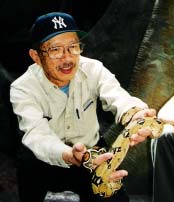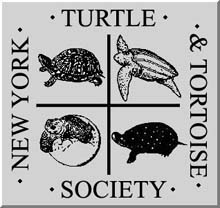 |
 |
The New York Turtle and Tortoise Society invites you to

Seminar 2005

Saturday, April 30, 9:00 a.m.–5:00 p.m.

The Linder Theater — American Musuem of Natural History
79th at Central Park West
New York City
(Use Security entrance on Central Park West)
|
The New York Turtle and Tortoise Society’s eighteenth Annual Seminar will be a full-day event, featuring four presentations. The fee for the day, which which includes lunch at the Museum Food Court, is $45 per person
We are pleased to return once again to the American Museum of Natural History for Seminar 2005. On Manhattan’s Upper West Side, easily accessible by public transportation, the Museum has been the site of our regular monthly meetings for more than 20 years. Visit the Museum’s Web site at www.amnh.org and Natural History Magazine, naturalhistorymag.com.
| Scheduled Program |
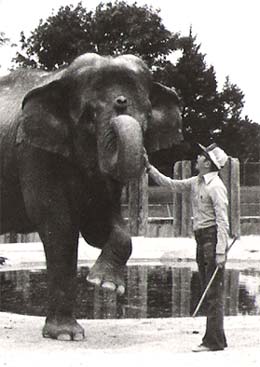
Ken Kawata and Gunda |
 Ken Kawata
Ken Kawata
General Curator, Staten Island Zoo

“Zoos, Herps and People: An International Perspective”

Reptiles are exhibited in zoos across the country in facilities specifically designed for them. This, however, is a relatively new phenomenon. Only several decades ago they were not considered a vital component of a zoo. Staten Island Zoo in New York, opened in 1936, played a pioneering role in emphasizing reptiles, under the direction of the legendary curator Carl Kauffeld, who began his training in herpetology at the American Museum of Natural History. He established the largest collection of rattlesnakes ever assembled in the world; in 1968 the zoo had 39 species and subspecies. Through his writings, Kauffeld's reputation was global; three decades after his death, the name prompts active conversations in herpetological circles.
In zoos of the world, including those in Europe and North America,
modern reptile exhibits are quite common today. However, the progress in this aspect has been uneven. For instance, even with a large number of zoos and aquariums in Japan, reptile exhibits did not generate much attention until the 1970s. Latin American zoos are also catching up in recent years.
In zoos herpetologists are known to be more technically inclined, have higher publication rates, get involved in fieldwork with non-zoo biologists and collect more books, compared with those who prefer to work with other animal groups such as mammals and birds. This is one puzzling aspect that persons in the field always have sensed, but never really sat down to articulate. Perhaps it is a subject for future exploration and discussion.
|
 |
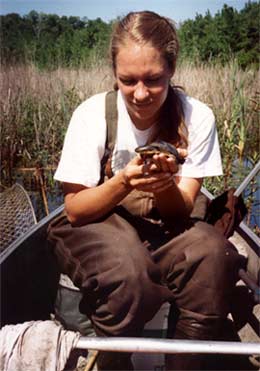
In 1990, Marla Emrich (above), then a graduate student in environmental studies at Bard College, created artificial nesting sites for Blanding’s turtles.
|
 Erik Kiviat
Erik Kiviat
Science Director, Hudsonia Ltd. and Professor of
Environmental Studies, Bard College, Annandale New York

“Conservation and Restoration of
Blanding’s Turtle Habitat in Dutchess County, New York”

I have studied the Threatened Blanding’s turtle in Dutchess County since the 1970s. My colleagues and I have conducted Blanding’s turtle surveys at a number of sites, and mapped potential habitats for this species in southwestern Dutchess. For the past 9 years we have worked on a habitat restoration project that I will describe in detail.
In 1996–97, approximately 1 ha of wetland and 3 ha of nesting habitat were constructed to mitigate the loss of wetland and nesting habitat destroyed during a school expansion in Dutchess County, New York. Organic soil sods with intact herbaceous and shrubby vegetation were translocated from the destroyed wetland to the constructed wetlands to accelerate development of the flooded, shrubby, organic-soil pools favored by Blanding’s turtles in Dutchess. The project included a 1300 m fence, on two sides of the mitigation area, with one-way turtle “gates” to reduce the risk of turtles leaving the area and entering parking lots or highways.
We collected one season of pre-construction data and are now in the ninth year of post-construction study of turtle activities, hydrology, soils, and vegetation. Adult Blanding’s turtles immediately and consistently used constructed wetlands in nesting season and summer, and nested on constructed upland habitats. However, there has been relatively little use of constructed wetlands in early spring and hardly any in winter. Adult use of constructed and nearby “natural” wetlands has been closely related to water levels. Nesting females selected soils with more gravel in wetter spring seasons and more sand in drier seasons, and hatchling productivity and length/weight ratio did not differ among years. Constructed nesting habitats gradually became overgrown with herbaceous weeds and females subsequently nested in small hand-weeded plots. Our studies have produced information for restoration and management of Blanding’s turtle habitats where this is necessary, and the expense of mitigation has apparently discouraged local developers from proposing similar projects.
|
 |

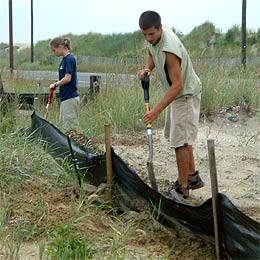
Bonnie and James erect barrier fence to prevent terrapins from crossing road. |
 Student Researchers of the Terrapin Conservation Program
Student Researchers of the Terrapin Conservation Program
The Wetlands Institute, Stone Harbor, New Jersey

“Terrapin Research and Conservation
at the Wetlands Institute”

Since 1989, the Wetlands Institute’s Diamondback Terrapin Conservation Project has engaged college and university students from all over the United States—and from foreign countries—to assist these creatures that are so desperately in need of our help. The following student researchers will report on their projects from the 2004 summer season:

Benjamin Atkinson — The great wall of Whale Beach: keeping nesting diamondback terrapins off the road. A pilot study investigated whether barrier fencing reduced road mortality.

 |
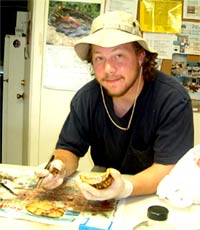
Ben Atkinson performing a
necropsy on a box turtle |
|
 |
James Casey — Tracking terrapins by sonic telemetry: tools, methods, and field experiences searching for diamondback terrapins in the salt marshes of southern New Jersey.

Ashley Kruegl — The types and frequencies of scute anomalies were analyzed in northern diamondback terrapins. Certain types of anomalies are more common than others. A relationship exists between nest temperature and anomaly frequency in hatchlings.

Bonnie Ludlow — Microchips are a standard method for uniquely identifying animals. Studies of some turtle species indicate problems with microchip retention. We examined the effectiveness of microchips for marking diamondback terrapins.

Laura Schoenle — The Dirt on Diamondbacks: A study of soil characteristics with respect to nest site selection in northern diamondback terrapins.

Mandi Shaw — Digestive tracts of 41 road-killed female diamondback terrapins were analyzed in order to determine the feeding habits of gravid females and look for evidence of internal parasites. Internal parasites are commonly found in turtles. Their absence in terrapins is unusual.
|
 |
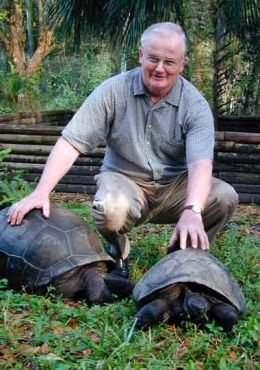
Peter Pritchard and with Aldabra tortoises at the Chelonia Research Institute, Oveido, Florida
|
 Peter C. H. Pritchard
Peter C. H. Pritchard
Chelonian Research Institute, Oviedo, Florida

“Tortoises of Africa”

Africa is the continent of elephants and rhinos, but it is also the tortoise continent, with more testudinid species than any other. They range from dwarfs at both ends of Africa—the diminutive Kleinmann’s tortoise in Libya and the tiny Klipschilpad in South Africa—to an exciting mélange in between that includes the world’s largest continental tortoise, the unique hingebacks, and the truly bizarre pancake tortoise.
The well-known author of Encyclopedia of Turtles and many other books on turtles is one of the world’s foremost experts on turtles and tortoises. His collection of over 6,500 turtle specimens, representing all 90 genera and 265 of the the known 294 species, is housed in the Chelonian Research Institute, which he founded in Oviedo, Florida.
Peter has spoken numerous times at the NYTTS Annual Seminar since 1987, covering such diverse turtle topics as “Turtles and Tortoises of Australia,” “Tortoises of Aldabra,” “In Search of Chitra indica,” “The Giant Tortoises of the Galápagos,” “Sea Turtle Conservation in Guyana,” “On the Trail of Rafetus swinhoei, the World's Rarest and Largest Freshwater Turtle,” “The Turtle Crisis in Southeast Asia,” and “The Pinta Island Tortoise, In Search of a Mate for Lonesome George.”
Through his scientific and popular writing, his films, and his speaking engagements, Peter has made turtles popular in the public mind, greatly increasing support for their conservation. In 2000, Time Magazine declared him a “Hero of the Planet.”
|
|
 |
|



